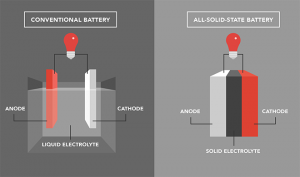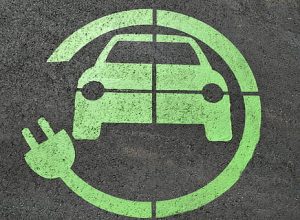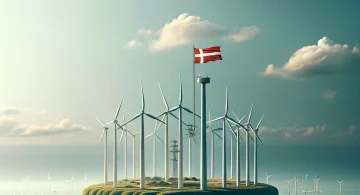ハードウェア
The State of Solid-State Batteries
Yaqub
Imagine this: an existing technology that is currently being tested that, when made publicly available, will be an instant revolution in energy. It guarantees to be safer and more efficient than anything currently in use. It will affect all electronics we do not consider to be a big deal, such as toys, smartphones, power tools, laptops. And also affect that in which we find to be more interesting, such as medical devices, spacecraft, and innovative new vehicle designs needed to reduce our carbon footprint. This tech has been known for centuries, yet we have only now begun to take incremental steps towards its creation. Tons of money is being poured into its research and tons more will be made once this technology has been perfected and released.
This description may sound a lot like nuclear fusion energy. However, it is actually referring to the innovations in the realm of battery technology, specifically solid-state batteries. And while both fusion energy and solid-state batteries are being regarded as technologies of the future, advancements and investments in solid-state materials have seen a steep increase in recent years. Today, there several major companies and credible researchers involved, and it looks like we may finally start seeing these batteries around in the next few years.
The question you may be asking yourself is, what can we expect once this elusive, transformative technology is finally ready for mass production?
Going back to the basics, batteries are nothing more than devices that store chemical energy and convert it into electrical energy. They typically have 4 major parts: the cathode, anode, electrolyte, and separator. The cathode and anode are called the electrodes. The role of the two electrodes is to produce our electric current. The electrolyte solution allows positively charged ions to flow between the two electrodes. This balances the flow of the electrons. The electrical current is produced when electrons are passed from one electrode to the other. In this case, electrons are passed from the negatively charged anode to the positively charged cathode. Finally, the separator keeps the two electrodes apart in order to prevent the battery from short-circuiting.
The one important difference between our current batteries and the solid-state batteries of the future is the electrolyte. Current lithium-ion batteries have an electrolyte that is in a liquid. Unfortunately, certain compounds present in this liquid electrolyte makes the growth of crystalline structures known as dendrites possible. These dendrites produce long, sharp bristles that can puncture the separator and cause a short-circuit, thereby leading to dangerous explosions. As the name suggests, solid-state batteries have a solid electrolyte that limits the growth of these harmful dendrites.
These batteries have higher energy densities and as such, the risk of fires and explosions is greatly reduced. They also take up less space, and it is able to operate in a wider range of temperatures.

Diagram representation showing crystalline dendrite structures reaching into the cathode causing a short-circuit
The largest drawback of electric vehicles today is their limited driving range. On average electric vehicle will get a range of around 400 km on a full charge. Fully charging the vehicle takes anywhere between 1 to 17 hours depending on whether charging location is at a charging station or using a standard outlet at home. Despite this, electric vehicles are expected to continue growing in popularity, eventually dominating the auto sector. To reach this point however, they will need to expand their range to at least 700 km while simultaneously being affordable to the consumer.
Imagine the following scenario: The driving range of electric vehicles double or triple the current number. Companies can choose between making a smaller, lighter battery that charges faster or leaving the battery the same size with a much more extensive range. Charge times are reduced to just 15 mins.
If we take a look at Samsung’s advancements in solid state batteries we see that they were able to develop a battery that can be charged and discharged over 1,000 times with a range of 800 km per charge. This is a battery life of 800,000 km. And all the while being able to operate efficiently in more extreme temperatures.
Something like this could spell the end for gas-powered vehicles. As for laptops and smartphones it means the devices could last several days on a single charge, with the lifespan of the battery increasing from 2 years to over 10 years. Medical devices could become more compact and portable while the larger temperature range means solid-state batteries could have applications in future space technology.
This potential has not escaped the attention of powerful companies. Major car manufacturers such as Volkswagen, Ford, BMW, Hyundai, Toyota, and even Bill Gates have all invested billions of dollars into solid-state battery research. Bill Gates backed a company called QuantumScape which made solid-state batteries with layers of ceramic that are resistant to dendrite growth and are able to operate in lower temperatures. Toyota has plans for a limited release of vehicles with solid-state batteries by 2025.
With regards to research, a research team has submitted a patent for a glass and ceramic solid-state battery that is stable, non-flammable, offers faster charging, and has 3 times more energy storage than a regular lithium-ion battery. This spectacular breakthrough was achieved by adding sodium or lithium to form an electrode in the battery. Additionally, the battery is affordable and is estimated to last over 2,000 charge and discharge cycles. Operating temperature range for the glass battery is between -20º C and 60º C. With the current pace of research, we may begin to see limited release of this technology in just 3 or 4 years, though it is hard to determine when the general public will have access to it.
Solid-state batteries represent a lot more than just convenience. It is a crucial part in saving the world as more capable electric vehicles can provide a drastic shift in the auto industry away from emission-heavy gas vehicles. Solid-state batteries may also be produced with earth-friendly materials like sodium that is abundant in the ocean. But perhaps more than anything, the arrival of solid-state batteries will represent the capabilities of our most brilliant minds to come up with revolutionary technology we could have only imagined for decades. Turning what was a technology of the future into the technology of today.


 2024/03/26
2024/03/26 2024/02/27
2024/02/27 2024/02/23
2024/02/23 2024/02/09
2024/02/09 2024/02/02
2024/02/02 2024/01/23
2024/01/23 2024/01/12
2024/01/12 2024/01/05
2024/01/05